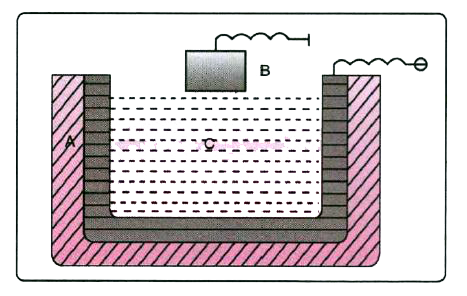Explain the term ' electrometallurgy' . At which electrode is the extracted metal always deposited.
Step-by-Step Solution:
Step 1: Define Electrometallurgy
Electrometallurgy is the branch of metallurgy that involves the extraction of metals from their ores through the process of electrolysis. This method is particularly useful for extracting metals that are higher in the electrochemical series, which means they are less reactive and cannot be easily extracted by traditional methods such as reduction with carbon.
Step 2: Explain the Process of Electrolysis
In the process of electrolysis, an electric current is passed through an electrolyte solution containing the metal ions. This causes the metal ions to migrate towards the electrodes, where they undergo reduction (gain of electrons) and are converted into solid metal.
Step 3: Identify the Electrode for Metal Deposition
During electrolysis, the extracted metal is always deposited at the cathode. The cathode is the electrode where reduction occurs, meaning that the metal ions gain electrons and are transformed into their metallic form.
Final Answer:
Electrometallurgy is the extraction of metals from their ores using electrolysis, particularly for metals that are higher in the electrochemical series. The extracted metal is always deposited at the cathode during this process.
---
Electrometallurgy is the branch of metallurgy that involves the extraction of metals from their ores through the process of electrolysis. This method is particularly useful for extracting metals that are higher in the electrochemical series, which means they are less reactive and cannot be easily extracted by traditional methods such as reduction with carbon.
In the process of electrolysis, an electric current is passed through an electrolyte solution containing the metal ions. This causes the metal ions to migrate towards the electrodes, where they undergo reduction (gain of electrons) and are converted into solid metal.
During electrolysis, the extracted metal is always deposited at the cathode. The cathode is the electrode where reduction occurs, meaning that the metal ions gain electrons and are transformed into their metallic form.
Electrometallurgy is the extraction of metals from their ores using electrolysis, particularly for metals that are higher in the electrochemical series. The extracted metal is always deposited at the cathode during this process.
Topper's Solved these Questions
- ELECTROLYSISBook:ICSEChapter:ELECTROLYSISExercise:Unit Test Paper 5 - Electrolysis
Explore 18 Videos
- ELECTROLYSISBook:ICSEChapter:ELECTROLYSISExercise:Fill in the Blanks
Explore 22 Videos
- ELECTROLYSISBook:ICSEChapter:ELECTROLYSISExercise:QUESTIONS FROM PREVIOUS ICSE BOARD PAPERS
Explore 96 Videos
- CHEMISTRY-2015Book:ICSEChapter:CHEMISTRY-2015Exercise:SECTION-II (40 Marks) Attempt any four questions from this Section.
Explore 49 Videos
- METALLURGYBook:ICSEChapter:METALLURGYExercise:UNIT TEST PAPER 6 - Metallurgy (Select the correct answer from the list A,B,C & given in each statement.)
Explore 5 Videos
Similar Questions
Knowledge Check
The electrode potential is the tendency of metal
Ato gain electronsBto lose electronsCto either lose or gain electronsDnone of these.
Explain the role of each of the following in the extraction of metals from their ores:
Silica in the extraction of copper.
View SolutionExplain the role of each of the following in the extraction of metals from their ores:
Zinc in the extraction of silver
View SolutionName the metal which is extracted from bauxite.
View SolutionMetals which can be extracted by smelting process are :
View SolutionThe following is a sketch of an electrolytic cell used in the extraction of aluminium.

At which electrode (A or B) is the aluminium formed ?
View SolutionExplain the term
i] metal activity or electrochemical series
ii] selective discharge of ions
View SolutionExplain the role of each of the following in the extraction of metals from their ores :
(i) CO in the extraction of nickel.
(ii) Zinc in the extraction of silver.
(iii) Silica in the extraction of copper.
View Solution